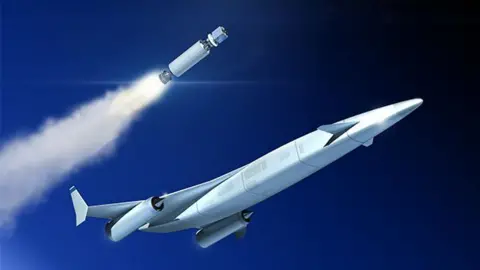The recent article titled “The British Jet Engine That Failed in the ‘Valley of Death'” chronicles the tumultuous journey of Reaction Engines, a pioneering British aerospace firm that attempted to revolutionize the engine technology used in aviation. Written by technology reporter Michael Dempsey, the piece delves into the emotional rollercoaster experienced by the company’s former chief technology officer, Richard Varvill, as he reflects on a career dedicated to the development of advanced aerospace technologies.
The saga of Reaction Engines can be traced back to the ambitious Hotol project of the 1980s, aimed at creating a hypersonic spaceplane capable of flying beyond the atmosphere. This innovative endeavor captured public imagination and showcased the potential of British engineering. Central to the Hotol project was the groundbreaking heat exchanger technology, which was designed to dissipate the extreme heat generated when air enters an engine at hypersonic speeds—temperatures reaching a staggering 1,000 degrees Celsius. Varvill explains that without effective cooling, the aluminium components of the engine would literally melt, making the task of harnessing hypersonic flight exceedingly challenging.
Fast forward three decades to October 2024, Reaction Engines was on the cusp of bringing this heat exchanger technology to life. The UK Ministry of Defence even provided funding to assist in hypersonic research, collaborating with Rolls-Royce on an unmanned aircraft. However, this support proved insufficient to sustain the company in the long run. Despite the high hopes and promising developments, Varvill reveals that key partnerships, particularly with Rolls-Royce, began to falter due to shifting priorities and budget constraints within the UK military.
As the company struggled to secure the necessary investment as 2024 drew to a close, Varvill noted the increasing reluctance from potential investors. The lengthy and complex process of bringing a new aerospace product to market, often referred to as crossing the “Valley of Death,” casts a long shadow over such ventures in aviation. This phrase aptly characterizes the precarious nature of transitioning revolutionary ideas into commercially viable technologies—a process that typically takes decades.
In a dramatic turn of events, the atmosphere at Reaction Engines turned somber during a final meeting called by the managing director, where employees were informed of the fate of the company. Varvill shares the harrowing experience of collecting personal belongings and accessing passes, a moment that left many employees in tears. Colleague Kathryn Evans, who headed the company’s efforts in hypersonic technology, expressed her disbelief, noting that while uncertainty loomed, she held onto a strong pipeline of opportunities until the very end.
The human side of the story is poignantly captured through their experiences of camaraderie and collective grieving as the company wound down. Many former employees opted to gather for a farewell party at Varvill’s home rather than a traditional pub outing. This decision reflected the deep investment they had in Richard Varvill’s vision for a future powered by their advanced technologies.
Despite the team’s heart and soul poured into Reaction Engines, investor reticence and financial constraints dashed their hopes. Adam Dissel, president of the US branch, expressed that a lack of excitement from major investors such as Boeing and BAE Systems ultimately quashed any likelihood of additional funding. He lamented that while the technology was highly developed and consistently functional, it lacked the necessary confidence from strategic backers to secure further investment and support.
Ultimately, the very foundation of Reaction Engines encapsulates a cautionary tale for high-tech ventures: the inability to procure funding can end innovation and aspirations abruptly. Varvill’s final reflection on the company’s collapse offers a stark resolution—stating simply, “We failed because we ran out of money.” This poignant statement underscores the challenges faced by pioneering companies striving to redefine the frontiers of technology against the unforgiving backdrop of financial realities.
As they navigate the closure, some team members still harbor hopes of a resurrection through the potential sale of Reaction Engines’ intellectual property. They wrestle with the haunting prospect of their work—once on the brink of groundbreaking innovation—being swept away into obscurity, a familiar narrative in the high-stakes arena of aerospace advancement. This heartfelt chronicle not only illustrates the technical ambition of the team but also highlights the human experiences and emotional investments tied to their journey, ultimately leaving readers to ponder the cost of innovation and failure in the high-tech world.



